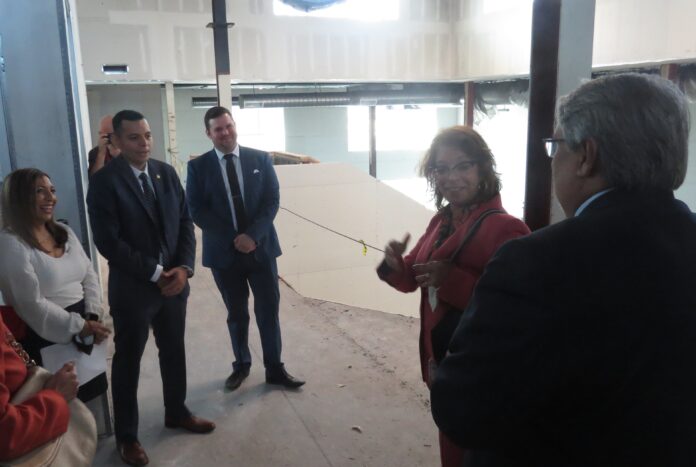
Alejandra Y. Castillo, assistant secretary of the U.S. Economic Development Administration, was in Brownsville Tuesday to tour the future eBridge Center for Business and Commercialization, which will be housed in the former La Casa del Nylon building at 1304 E. Adams St. once extensive renovations are complete.
The business-incubator project, spearheaded by the Brownsville Community Improvement Corporation, is made possible in part by a $900,000 grant from EDA combined with a $500,000 match from BCIC.
The project’s other collaborators include the city of Brownsville, Brownsville Chamber of Commerce, Lower Rio Grande Valley Economic Development Council, Texas Southmost College, U.S. Economic Development Administration, U.S. Small Business Administration, University of Texas Rio Grande Valley and the UTRGV Entrepreneurship and Commercialization Center.
Representatives from each organization were along for the tour, as were Filemon Vela and Vicente Gonzalez of the Valley’s congressional delegation. Vela said EDA has been instrumental in moving a long list of projects forward in and around Brownsville, including the eBridge Center, Brownsville South Padre Island International Airport and the South Texas Ecotourism Center, which held its grand opening Tuesday morning.
Vela said the assistance from EDA Regional Director Jorge Ayala and his predecessor, Pedro Garza, has been invaluable through the years.
“They’ve almost been like part of our congressional team,” Vela said. “They’ve been there all along.”
Castillo said EDA has been part of eBridge since the beginning and that the agency was drawn to the project because of the potential “multiplier effect,” meaning the positive economic ripples it is expected to create for the area.
“We are custodians of taxpayer dollars, so when we invest in these projects we want to make sure that there’s a multiplier effect, that it’s creating jobs, that it’s actually diversifying the economy in terms of entrepreneurs, the type of entrepreneurs,” she said. “There were a lot of elements of this particular project that were very much in line with what EDA does. So this is exciting, because this is about planting the seed of those industries of tomorrow.”
Part of EDA’s mission involves creating more non-traditional entrepreneurs, such as Hispanics, African Americans, women and residents of rural areas, and eBridge will help do that, Castillo said. Everyone locally should be excited about this new asset, which will serve as a resource center for entrepreneurs and benefit the community as a whole, she said.
Castillo added that growing the necessary workforce goes hand in hand with creating the jobs of tomorrow and is also a major focus of
EDA.
Josh Mejia, BCIC president and CEO, said he believes this was the first time Brownsville has received a visit from the assistant secretary of EDA.
“They’ve shown a keen interest in the vision and impact of our project, and it was just a matter of time before they decided to come down and visit and be able to see and experience it,” he said.
“It’s about time that we celebrate these wins so the community can start seeing the transformational change that this project’s going to create,” Mejia said.
The eBridge center is already at capacity out in terms of tenants even before it opens, though BCIC is already making the case for expansion, he said.
“These centers specialize in creating jobs primarily,” Mejia said. “How they do that is really based on the real challenges that entrepreneurs face in their respective areas. For our center, we’ve really designed things from the bottom up based on the real-world challenges that are happening here in our area.”
The objective is to enable any entrepreneur with an idea to turn it into a commercial venture that can be scaled up and “grow tremendously,” he said.
Labor and supply issues have thrown a wrench in the planned construction timeline, Mejia said, though he credited the project’s contractors for having foresight to help mitigate those issues.
“We’re still looking at early summer to be able to fully open our doors,” he said.




